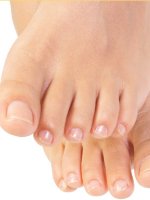
|
Fungal Guide
.ca
Fungal Infections Treatment Information.
|

|
| Fungal Guide | About Us | Dermatology Glossary | Skin Care Network | Fungal Guide Site Map |

Common Rashes of the Feet
When to seek treatment
Walking is one of the best forms of exercise, but sore feet can impede a good habit. When feet get sore from common rashes, it is important for your health to seek treatment. Common rashes are caused by fungus, allergies, sweating in footwear, or stress. If these rashes go untreated, bacteria can infect the feet. Read about these types of infections on Fungal Guide
Tinea Pedis
Known as athlete's foot, tinea pedis is one of the most common skin problems. Caused by a fungus, tinea pedis is spread by contact, often in public places such as locker rooms and gyms. It is more prevalent in men and can infect the groin. On the feet, the fungus can move from skin to toenails and vice versa. Infected feet may itch, have an unpleasant odor, and be painful from skin cracks. Tinea pedis can be cured by diligent treatment:
- Wear cotton or absorbent socks, and change socks and shoes when feet sweat.
- For early skin infections, Loprox or Lamisil creams are effective.
- Penlac is applied as a lacquer on the nail and treats early or mild nail infections.
If the fungus does not respond to creams or nail lacquer, an oral medication such as terbinafine is prescribed, although its side-effects must be monitored.
Dyshidrotic Eczema
Dyshidrotic eczema is a recurring rash on the soles and toes that affects mostly young adults who are prone to allergies and under stress. Very itchy, tiny blisters develop into a dry and fissured rash. Learn more on www.EczemaGuide.ca
Early treatment includes:
- applying a compress of saline, tap water, or 10% aluminum acetate
- a moderate-to-high potency topical steroid cream
- immunomodulators that alter the body's immune response, such as Elidel and Protopic
- antihistamines and prednisone to reduce allergic reactions
- oral antibiotics for bacterial infection
Chronic rashes are treated by a moderate-to-high potency topical steroid ointment and alternating treatments of topical corticosteroids and immunomodulators.
Juvenile Plantar Dermatosis
Also known as sneaker dermatitis, this rash is common in children up to the age of 15 who have allergies such as hay fever, asthma, or eczema. The rash is tender and inflamed on the weight-bearing forefoot and toes. The skin may crack but not blister. The condition is worsened by sweating in footwear.
To treat plantar dermatosis:
- Wear shoes that allow ventilation, and socks that are cotton or absorptive.
- Apply a mild steroid ointment that is prescribed.
- To relieve cracked skin, try petroleum jelly, tar ointments, or zinc paste.
Pustular Psoriasis
Pustular psoriasis is a form of psoriasis, of which the cause is unknown. It can affect the entire body or just the palms and soles. On the palms and soles, small blisters appear with or without pus, and then turn brown and scaly. (See www.PsoriasisGuide.ca )
Treatment includes:
- a medium-to-potent steroid ointment
- calcipitriol with a corticosteroid (Dovobet)
- high-intensity ultraviolet light
- oral medications Soriatane or Trexall
Contact Dermatitis
Contact dermatitis can be caused by irritation or allergies to ingredients used in footwear, such as:
- leather tanning products
- glues, dyes, and rubber
- preservatives such as formaldehyde
An itchy, red rash with small blisters may appear at the area of contact, such as near the tongue of a shoe. The condition can worsen during hot weather when the feet tend to sweat. The allergen must be identified (by patch-testing if necessary) and avoided. A topical corticosteroid is recommended.
Because advanced rashes can be hard to treat, be diligent about taking your medications. Relapses are common with tinea pedis. Pustular psoriasis is not often cured, but it can be controlled. Allergies can be life-long, so avoidance of allergens and stress are necessary antidotes.
Dr. Ronald Vender is a dermatologist in Hamilton, ON and director of Dermatrials Research. He is Associate Clinical Professor of Medicine in the Department of Dermatology at McMaster University. He is also Active Staff and Head of the Service of Dermatology at St. Joseph's Hospital, Department of Medicine.
Back to Fungal Infections Articles Index